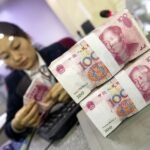In the middle of an otherwise mundane Congressional hearing on July 9, US Treasury Secretary Janet Yellen made an extraordinary admission: De-dollarization is now her biggest fear.
Though it might sound obvious to many, it’s a stark about-face for a US economy czar who’s long denied the dollar is in danger of losing its status as dominant reserve currency because of sanctions or other policy missteps. In March 2022, for example, Yellen said “I don’t think the dollar has any serious competition and it’s not likely to for a long time.”
The former Federal Reserve chair noted that “when you think about what makes the dollar a reserve currency, it’s that we have the deepest and most liquid capital markets of any country on earth. Treasury securities are safe, secure and immensely liquid. We have a well-functioning economic and financial system and the rule of law. There really is no other currency that can rival it as a reserve currency.”
What a difference two years have made. Fears of a “weaponized” dollar have the Global South joining forces with increasing urgency to find an alternative.
And two dynamics in Washington are accelerating this dynamic in real time. One is the US national debt careening toward the US$35 trillion mark. The other is an increasingly off-the-rails US election cycle the likes of which global investors have never seen.
Already, Donald Trump is telegraphing 60% tariffs on all Chinese goods, at least. The former US president is threatening a 100% tax of all cars entering the US. That has Joe Biden’s embattled White House looking to out-Trump Trump on trade with its own China trade war.
Add in uncertainty about whether Biden will even be the Democratic Party nominee. Questions abound about the president’s cognitive health following his disastrous June 27 debate versus Trump.
As the odds of a Trump 2.0 White House increase, Asia – while worrying that Trump may get another shot at some controversial items on his 2017-2021 wish list – is suddenly confronted with the “Project 2025” game plan devised by his surrogates.
Included in the 900-page Project 2025 scheme created by the Heritage Foundation is talk of abolishing the Federal Reserve and returning to a gold-backed currency. Trump in the past has hinted at defaulting on US debt, devaluing the dollar and shaking down allies that host America troops – such as Japan and South Korea – for protection money.
Even if he loses the November 5 election, Trump will almost certainly claim fraud. Already, Trump and his top allies refuse to commit to accepting a loss, virtually ensuring another Capitol Hill insurrection akin to January 6, 2021.
It’s worth remembering that the political polarization behind that riot contributed to Fitch Ratings’ August 2023 revocation of Washington’s AAA status. Since then, Moody’s Investors Service, the keeper of Washington’s only remaining AAA, has pointed to clashes over funding the government and raising the statutory debt ceiling as threats to outlook.
The fallout from a potential Moody’s downgrade worries Asia greatly. This region is sitting on the largest stockpiles of US Treasury securities anywhere — roughly US$3 trillion. Japan has the most at US$1.2 trillion; China is second with $770 billion.
Yet Yellen’s tenure could be remembered as the one during which the momentum really shifted against the dollar. It was clear by 2022 and 2023, argues economist Stephen Jen, CEO at Eurizon SLJ Capital, that the dollar’s loss of market share was accelerating. It was last year when the dollar’s tally of total global official reserves fell to 58% from 73% in 2001 – back when it was, in Jen’s words, an “indisputable hegemonic reserve.”
“The dollar suffered a stunning collapse in 2022 in its market share as a reserve currency, presumably due to its muscular use of sanctions,” Jen argues. “Exceptional actions taken by the US and its allies against Russia have startled large reserve-holding countries” – most of the Global South, emerging economies.
Though King Dollar still reigns, Jen argues, its continued dominance “is not preordained” amid efforts among the BRICS – Brazil, Russia, India, China, South Africa – and elsewhere, including Southeast Asia, to de-throne the US currency.
“The prevailing view of ‘nothing-to-see-here’ on the US dollar as a reserve currency seems too innocuous and complacent,” Jen argues. “What needs to be appreciated by investors is that, while the Global South is unable to totally avoid using the dollar, much of it has already become unwilling to do so.”
Why, then, would the Washington establishment be playing into the hands of those most keen on dislodging the dollar?
Yuan internationalization has been a top priority of Chinese leader Xi Jinping’s time in power since 2012. Odds are good that the yuan’s global role will grow exponentially as China modernizes its economy.
Yet Beijing’s reluctance to allow full convertibility limits the yuan’s utility. So do doubts about the yuan’s trajectory, suggesting Xi’s de-dollarization drive is working better overseas – in terms of trade and official aid – than at home.
One answer is for Xi and Premier Li Qiang to step up reforms for the property sector, local government finances, capital markets development and recalibrating growth engines from exports to services and innovation. Also, Beijing must make the yuan fully convertible to increase trust.
The problem, says Alexandra Prokopenko, a senior fellow at the Carnegie Russia Eurasia Center, remains that “it’s believed that the yuan can’t become a full-fledged reserve currency because of the current restrictions on capital transactions in China.” Though growing yuan use by Russia and other sizable economies is “helping the Chinese authorities to make it into an international reserve currency,” Prokopenko notes, structural limitations mean it’s “hardly a reliable substitution” for the dollar as yet.
Still, Xi’s “yuanization” gambit is gaining traction. In March, the yuan hit a record high of 47% of global payments by value.
Since 2016, Team Xi has made steady and material progress toward supplanting the dollar as linchpin of the global financial system. That year, Beijing secured a spot in the International Monetary Fund’s “special drawing-rights” program. It put the yuan into the globe’s most exclusive currency club along with the dollar, euro, yen and the pound.
In 2023, the yuan topped the yen as the currency with the fourth-largest share in international payments, according to financial messaging service SWIFT. It also overtook the dollar as China’s most used cross-border monetary unit, a first.
The strategy would get a major boost from Trump engineering a weaker dollar. That would greatly reduce trust in US Treasury securities, a cornerstone holding for central banks around the globe, boosting America’s borrowing costs.
The scheme would imperil Washington’s ability to defy financial gravity. Thanks to reserve-currency status, the US enjoys any number of special benefits. This “exorbitant privilege,” as 1960s French Finance Minister Valéry Giscard d’Estaing famously called it, allows Washington to live far beyond its means.
All this explains why the dollar continues to rise even as Washington’s national debt approaches US$35 trillion. The dollar is up 13% so far this year versus the yen and 11% versus the euro.
Biden’s White House also imperiled trust in the dollar. Along with continued debt accumulation, Team Biden’s decision to freeze portions of Russia’s currency reserves over its Ukraine invasion crossed a line with many global investors.
Dmitry Dolgin, economist at ING Bank, thinks yuanization remains largely on the agenda. Beijing hasn’t let up on broadening currency swap arrangements, promoting yuan transactions and expanding China’s Cross-Border Interbank Payment System (CIPS) aiming to replace SWIFT.
“It appears that China’s expanding trade ties and financial infrastructure suggest that the potential for further yuanization has not been exhausted,” Dolgin says.
Neither have efforts to create a BRICS currency. BRICS has even greater firepower, considering it’s allying with Iran, Egypt, Ethiopia, the United Arab Emirates and others. At last week’s Shanghai Cooperation Organization summit, China, Russia and their geopolitical comrades did their best to “to show the world that the West’s attempts to contain them are not working,” notes Tom Miller, analyst at Gavekal Research.
In June, the yuan’s share of Russia’s foreign exchange market hit 99.6%. That’s a direct result of sanctions that forced the Moscow Exchange to halt dealing in dollars and the euro. In May, prior to the implementation of new US sanctions, the yuan’s share was just 53.6%.
Not everyone is convinced the dollar is doomed. Analysts at the Atlantic Council’s GeoEconomics Center think the dollar’s dominance is actually growing. Its brawn is driven by a buoyant US economy, attractive yields and geopolitical uncertainty.
One problem, they write in a recent report, is that China’s currency isn’t ready for prime time.
“This is possibly because of reserve managers’ concern about China’s economy, Beijing’s position on the Russia-Ukraine war and a potential Chinese invasion of Taiwan contributing to the perception of the renminbi as a geopolitically risky reserve currency,” Atlantic Council analysts argue.
But the preponderance of available evidence suggests that, as 2024 unfolds, Yellen’s fears about de-dollarization aren’t just valid – they’re being realized by the day.





















